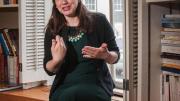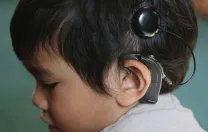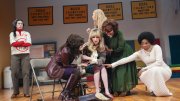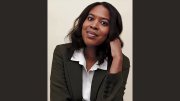For the first time in more than two decades, Harvard began offering an American Sign Language (ASL) course last fall. Assistant professor of linguistics Kathryn Davidson, who works on sign languages, happened to join the linguistics department in 2015—at the same time that students were calling for ASL classes—and signed the paperwork to get the course approved. When she was a graduate student at the University of California, San Diego, Davidson says, sign language researchers were everywhere; at Harvard, ASL is much less visible, and she hopes, through ASL classes and interpretations at events, to make sign language “a more natural part of what’s going on.” But she doesn’t teach the class, and language instruction has little to do with her research. She isn’t a signer of ASL—most linguists who conduct research on a language aren’t necessarily fluent speakers. Davidson is a semanticist, which means she’s interested in how human beings can hear (or see, in the case of sign languages) infinitely many new sentences they’ve never heard before and understand them. She gesticulates in excitement when she talks about language, almost flailing: “What is this thing that we’re so good at?”
Even for the educated public, understanding what linguists do can be an ordeal. The simplest definition—that linguistics is “the scientific study of language”—does not say much. We all use language, so what could be so complicated about studying it? People often assume that linguists are concerned with enforcing prescriptive rules about language—one shouldn’t end a sentence with a preposition, use a split infinitive, and so on—but linguists actually have no interest in top-down rules. (At a dinner party, an especially bellicose linguist might point out that both of those “rules” were forcibly imported by nineteenth-century grammarians and have nothing to do with English grammar.) What they find much more interesting are the naturally occurring rules of language that people pick up effortlessly as small children. People’s innate capacity for language might also explain why it’s hard to understand what linguists study: we’re so good at internalizing the rules of language that it’s difficult to surface them as rules that even need studying.
But Davidson finds that when she tells people she works with sign language, they get it: “Somehow that gives people the signal that you’re interested in the brain and how different languages differ.” Davidson’s work on sign languages spans the divide between applied and theoretical linguistics, contributing to both abstract debates about language in the mind and questions with immediate impacts on people’s lives. Harvard’s small but formidable linguistics department thrives on its interest in the union of theory and empirical research. “Our department retains its ties to languages, plural, in a way that a lot of other modern linguistics departments don’t,” Davidson says. “We definitely have strong theorists…but all of them are really also strongly tied to working on specific languages that aren’t English.”
To explain the human capacity for language, MIT linguist Noam Chomsky, JF ’55, LL.D. ’00, supposed that there must be a uniquely human language “organ” embedded in the DNA, with neural hardware devoted specifically to acquiring and processing language. Chomsky composed the now-famous sentence, “Colorless green ideas sleep furiously,” as an example of an utterance that makes no sense semantically, and yet any native English speaker could recognize it as a grammatically valid English sentence. He proposed the language organ to account for our ability to assimilate new sentences, regardless of their semantic content. Drawing on Chomsky, Johnstone family professor of psychology Steven Pinker popularized the concept of language as a discrete endowment in his 1994 book, The Language Instinct.
Whether such an endowment really exists remains an open question within linguistics. At the other extreme, some academics argue that language is merely a consequence of humans having a lot of gray cells—that it does not differ fundamentally from any other learned skill, like adding numbers or playing the piano. Those who believe the latter tend to come from fields outside linguistics, says Diebold professor of Indo-European linguistics and philology Jay Jasanoff. “Linguists are infinitely appreciative of how unique and special this language capacity is,” he adds, and tend to take for granted that a language organ, in some form, exists.
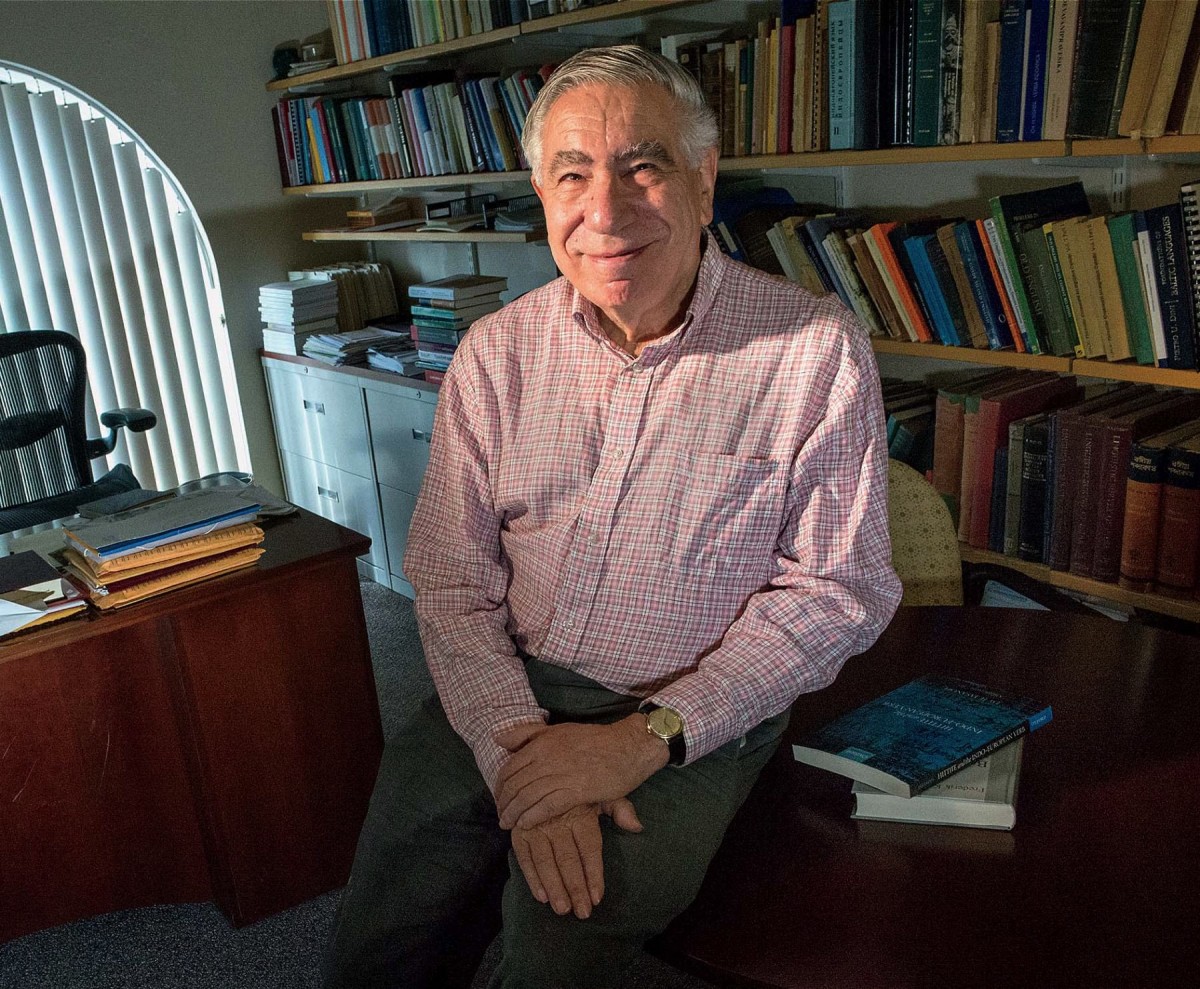
Jay Jasanoff
Photograph by Jim Harrison
In the twentieth century, linguists recognized that ASL and other sign languages were languages in their own right, rather than just attempts to gesture in lieu of real language (see “Social Justice in Linguistics”). That difference—between a full or “natural” language and any other system of communication—isn’t a trivial one. A natural language has to be acquirable by children during the critical period for language acquisition, up to around age 12. It also must be able to say anything that a person might want to say. So the Bible, for example, can be—and has been—translated into Cherokee, or ASL, or any other language. (In the introductory linguistics course that she teaches, Davidson recalls students discussing whether emoji are a language. They aren’t, because they can’t unambiguously communicate anything that a speaker wants to say: you can’t write the Bible in emoji.)
Sign languages are fertile territory for answering questions about human language capacity, because they stretch the medium of language transmission from the auditory to the visual. They’re often used by people who had limited aural language input as children. While she was postdoctoral fellow at the University of Connecticut, Davidson studied the English abilities of deaf children with cochlear implants. Many deaf children born in the United States are given such implants early to restore their hearing, with variable rates of success, and often their parents are advised to focus on English and avoid sign language. “The medical community has expressed repeated concern about ‘visual takeover,’” Davidson explains. “Under this view, if you’re exposed to sign language, your brain will not put the effort into using the cochlear implant to process speech because sign language is just too easy in comparison.” (Within the organized deaf community, cochlear implantation is an issue of some debate: restoring the hearing of deaf children allows them to communicate with the rest of society, without the use of an interpreter, but it also threatens the survival of deaf culture, of which sign language is a central part.)
To determine whether fears of a “visual takeover” could be supported, Davidson and her coauthors Diane Lillo-Martin and Deborah Chen Pichler focused on a group of deaf children with cochlear implants, born into deaf families, who had regular exposure to both ASL from their parents and spoken English from outside the home. She gave them standardized English tests—for comprehension, articulation, basic vocabulary, and literacy—and compared the group’s results to a control group of hearing children born to deaf adults, who also grew up signing ASL with their parents and using English elsewhere. The deaf children performed just as well as the hearing group; in fact, they did better than deaf children with cochlear implants who lack exposure to ASL typically do. Those findings appear to confirm Chomsky’s intuition about language capacity. “Early ASL input was doing whatever bilingualism would naturally do, but it wasn’t putting [the deaf children] at any disadvantage for learning spoken language,” Davidson says. “They were processing English phonology very well. They were on the high end of cochlear implant users, and they did much better than would be predicted by their age of implantation and other factors about their implants. You might conclude that this is because they had sign language, not in spite of it.”
The worry that a visual language could “take over” the aural realm, making deaf children unable to process spoken language, seems consistent with what the medical community already knows about the brain. In deaf and blind people, for example, neuroplasticity allows the parts of the brain normally used for auditory or visual processing to be used to process other senses instead. If language is just another learned skill processed through the senses, then allowing a deaf child to use sign language could encourage her visual capacity to eclipse the auditory realm, making it harder for her to understand spoken language via cochlear implants.
Davidson’s findings, and those of the linguistic community in general, provide evidence of a generalized capacity for language—a language organ—which is exercised with sign languages just as it is with spoken ones. Sign language doesn’t appear to take over space used for processing spoken language. In fact, early exposure to ASL may aid processing of spoken English. Because early language exposure is central to children’s language acquisition, depriving deaf children of ASL input early in life, before they get implants, Davidson suggests, does much more harm to their language ability later.
The Chomskyan program
A central assumption of the Chomskyan paradigm is not just a language organ but a universal grammar: a notion that all natural languages must have a common, underlying structure in order to be processed by the language faculty. Linguists use the term universal grammar more or less interchangeably with language organ or language instinct to refer to the theoretical language blueprint innate to humans. Pre-Chomskyan linguistics, which arose from the work of Swiss linguist Ferdinand de Saussure, was concerned with the structure of languages: how they combine different sounds and pieces of words to form utterances. Saussure was also interested in how languages change over time, and made the important observation that words are arbitrary. Linguists are still invested in language change over time and the structure of individual languages, but those questions have been in significant part displaced by the debate over Chomskyanism. In his review of Chomsky’s foundational book Syntactic Structures, the study that would begin a paradigm shift in linguistics, MIT linguist Robert Lees wrote that its approach would elevate linguistics to an abstract science with explanatory power, rather than a catalog of the world’s languages and their grammars. “If you really believe strong claims about universal grammar,” Jasanoff says, “you’re not going to take a particularly generous view of research on the semantics of words relating to human relationships in a language of the Amazon. You’re going to say that’s all low-level stuff that doesn’t concern the main questions.”
Linguists now can name many things that all languages have in common, and many things that no language is able to do, but they remain far from understanding what the universal grammar actually consists of. Recently, more researchers from linguistics and other fields have come to doubt that a language instinct even exists, pointing out, for example, that it takes children years to successfully acquire a language, and they pick up the rules piecemeal, not systematically. The theory of a language organ, they argue, is so vague as to be unfalsifiable. Chomsky had famously refuted Harvard behaviorist B.F. Skinner’s view of language as a form of behaviorist learning, where children merely learn to associate words with meanings. Like structural linguistics, behaviorist psychology was concerned only with behavior outside the mind, because mental processes weren’t empirically observable. Now, Chomsky’s opponents worry that linguistics has swung too far in the opposite direction, that his purely computational theory can’t account for the role of learning in language. The more interesting views fall somewhere along the spectrum: “I think it’s vain and arrogant to suppose that we’re really at the point of being able to figure out exactly what the language organ is, and that our language abilities are due 100 percent to the language organ and 0 percent to generalized gray matter,” Jasanoff says. “I think it’s clear that there is some universal grammar, something that we are endowed with that apes don’t have, but there’s a great continuum between having an extremely structured view of what this is and having the view that it’s nothing.”
Jasanoff completed his undergraduate training in linguistics at Harvard in 1963, a few years after Chomsky published Syntactic Structures. The object of study in the Chomskyan tradition, also called generative linguistics, became not individual language systems but the human mind. Significant resistance to Chomsky emerged among the old guard of linguists—“violent anti-Chomskyanism,” as Jasanoff calls it—but it never animated Harvard’s linguistics department the way it did some institutional peers. It maintained good relations with MIT’s department and remained generative in its outlook. At Columbia, once one of the strongest U.S. linguistics departments, the faculty was so unable to cope with the Chomskyan wave that it eventually disintegrated.
Linguistics at Harvard
Harvard’s department remains one of the most distinguished linguistics programs in the nation, reflecting the strength of its faculty and its ability to draw on the University’s language and area-studies programs and psychology department. But even at Harvard, linguistics suffered a crisis in the decades after Chomsky. Nearly all the department’s current faculty members arrived during the last two decades; the department fell into disrepair in the 1980s and 1990s, during what Jasanoff calls a “perfect storm” of dysfunction among senior professors and low morale among junior faculty, who at the time lacked a straightforward path to tenure. “There was a contagion among Ivy League deans to save money by doing away with linguistics,” Jasanoff says. (Linguistics was also nearly eliminated at Yale in the early 1990s.) By 1993, Harvard had announced it would eliminate its department: “The two senior professors who were leading [it] were called into the dean’s office and told that a committee would be appointed to study ways of covering linguistics at Harvard without a department.”
My fascination with linguistic evolution exactly paralleled my fascination with biological evolution; the historical mutation of language forms into others is exactly like the historical mutation of a fin into a tetrapod limb.
Recalling that period, the Slavic department’s Michael S. Flier, Potebnja professor of Ukrainian philology, writes, “I immediately wrote a letter of concern to Jeremy Knowles [then dean of the Faculty of Arts and Sciences], emphasizing how important it was for Harvard to have a strong representation in linguistics.” And the following summer, the department was placed into a kind of receivership under Flier, who was charged with putting it back in order. Linguistics was permitted to make new appointments (among them Jasanoff, who started in 1998 as the department’s Indo-Europeanist), and to move, as Flier puts it, “out of its claustrophobic space in the basement of Grays Hall.” The department now has three full-time tenured professors and a fourth shared with the classics department, and, during a period of general austerity for the humanities at Harvard, is conducting a search for a new senior colleague.
For years, Jasanoff has taught “Introduction to Indo-European,” an entry-level historical linguistics course in which students reconstruct Proto-Indo-European, the parent language of the languages of Europe and parts of Central and South Asia, probably spoken more than 5,000 years ago. It has typically enrolled 20 to more than 30 students; when last he offered it, in spring 2015, 35 students signed up. This spring, 68 students did—so many that he moved the class to Boylston Hall’s Fong Auditorium as “an emergency measure.” Jasanoff attributes the growth to Harvard’s new General Education system, which lets students take any linguistics course to satisfy the arts and humanities requirement. (Previously, linguistics courses didn’t satisfy any Gen Ed requirements.) “The reason this is popular,” he says, “is this stuff is extremely interesting. It piques the interest of a lot of kids. For a lot of students, when they first take linguistics, scales fall from their eyes.”
For historical and bureaucratic reasons, linguistics is wedged into the Faculty of Arts and Science’s arts and humanities division, but methodologically, it isn’t a straightforward fit anywhere. There’s little interpretive work in what Jasanoff does, he says, using old written records to reconstruct, for example, the accent pattern in a Slavic language. He first became aware of historical change in language in high school, a process he viewed with a scientist’s eye: “My fascination with linguistic evolution exactly paralleled my fascination with biological evolution; the historical mutation of language forms into others is exactly like the historical mutation of a fin into a tetrapod limb.”
Generative linguistics relies on formal logic to model meaning. Davidson entered linguistics through mathematics, thinking that she’d be a math professor. She stumbled into the field in college at Penn, through a general education requirement. (Had she gone to Harvard in that era, she might never have found it.) “A very common entry into linguistics in the post-Chomsky era is people who have really math-y and analytical minds and like to think about cognitive science, how you model mental processes, how you translate from one language to another,” she says. “Those are questions that don’t involve any lab science, but still scientific questions you could approach with a mathematical apparatus.”
Plenty of students enter the field through humanistic passions, too, like a love of language, or anthropology. Entire subfields are devoted to the social and political dimensions of language, though they have a lesser presence at Harvard than elsewhere. Davidson points out that Harvard attracts the kinds of undergraduates who don’t like to be limited by the arbitrary boundaries between disciplines; for them, linguistics can feel liberating, allowing them to draw on many different intuitions. “Harvard students in particular were good at learning all their high-school languages and were taking advanced calculus,” she says. “It’s natural for those kinds of people to be excited about linguistics.”
The birth of a language
When she was in college at Wellesley, Annemarie Kocab (now a psychology graduate student who will be a postdoctoral fellow in Davidson’s lab next year) worked with Jennie Pyers, a psychologist who studies Nicaraguan Sign Language (NSL), a language that emerged in Managua in the 1980s, and today has more than 1,000 native speakers. For linguists interested in language emergence, NSL offers a rich and rare natural experiment. “[I]t’s the first and only time that we’ve actually seen a language being created out of thin air,” Steven Pinker has said.
NSL’s origins trace to an attempt by the Nicaraguan government in the late 1970s to establish a special-education school that drew dozens of deaf students. The program initially tried to teach them Spanish through techniques like lip-reading; these largely failed. What followed was much more interesting: the children began to use gestures with one another that weren’t comprehensible to their teachers. Within several years, it became clear that this was the birth of a new language. American academics have been traveling to Nicaragua since the late 1980s to gain insight into how languages emerge.
In spoken language, the closest analogy to NSL’s emergence might be pidgins and creoles. Pidgins arise in situations of cross-cultural contact, like trade or colonialism, where adults speaking two different languages must find a way to communicate. The resulting pidgin, a makeshift mixture of both languages, lacks the grammar and vocabulary of a natural language. When a new generation of children acquires the pidgin, they rapidly fill in semantic and syntactic gaps, producing creoles: full, stable languages, like Haitian Creole.
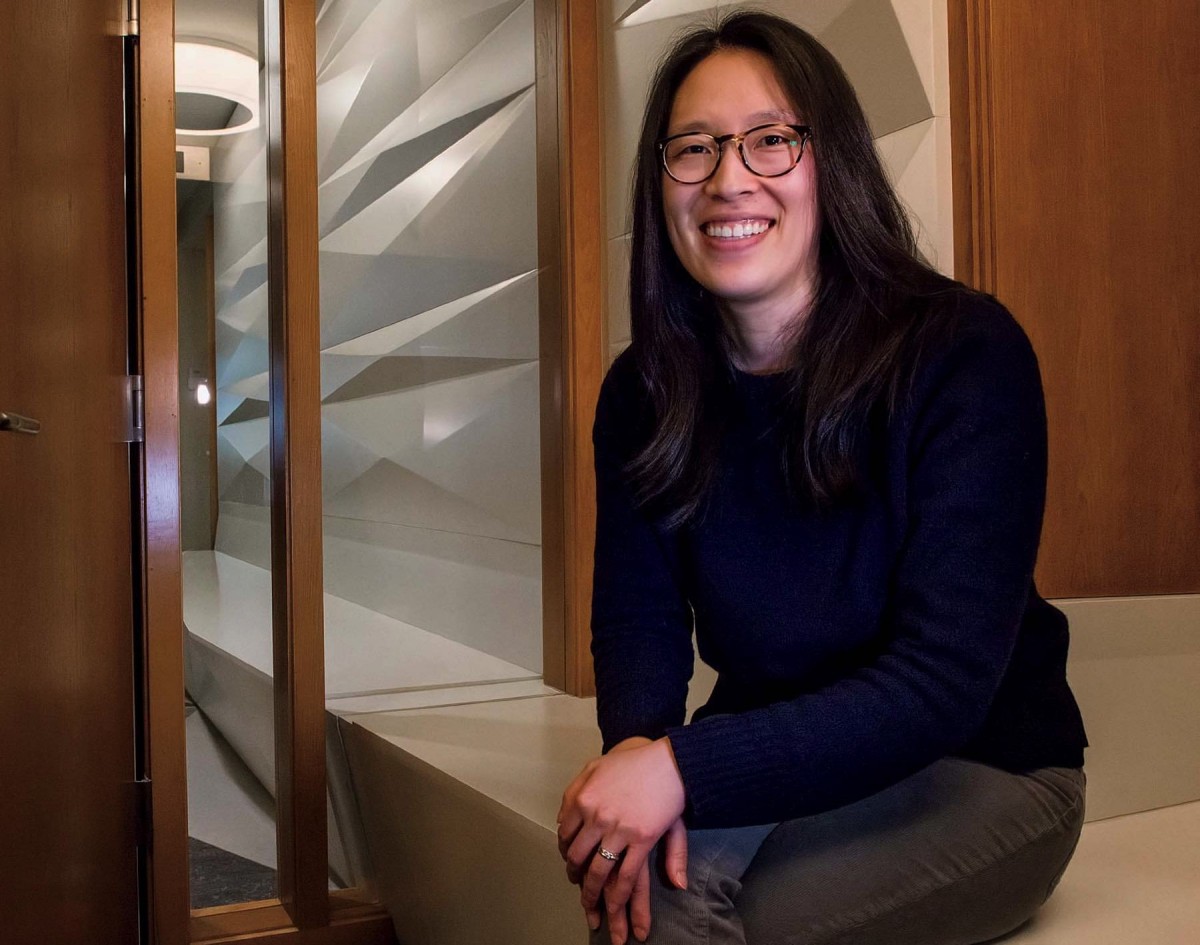
Annemarie Kocab
Photography by Jim Harrison
A similar pattern emerged in Nicaragua. The first cohort of NSL signers, from approximately the late 1970s through the mid 1980s, began to converge on a common vocabulary and sentence structure. “The first cohort tends to sign more slowly, at a more measured pace, and they don’t consistently use what we would call grammatical ‘space,’” Kocab explains. (In sign languages, the space in front of the signer is used systematically to communicate grammatical information. A signer might introduce someone in a particular location, for example, and refer back to that location to talk about that person.) The next cohort began to sign faster and more fluently, and made grammatical use of space. More than 30 years have passed since the emergence of the first cohort of speakers, allowing Kocab and other researchers to begin to make generalizations about the language’s development.
Kocab is interested in how NSL signers develop ways of communicating about complex topics, like events ordered in time. In one study, she and her coauthors, psychology professors Ann Senghas of Barnard and Jesse Snedeker of Harvard, showed signers videos of events in different times and asked them to discuss them. Participants were drawn from the first cohort, the second cohort, who entered the signing community in the late 1980s, and the third cohort, who entered in the 1990s. All of them began signing as young children, and today are adults in their twenties, thirties, and forties. Some of the findings seem intuitive: signers from all three cohorts successfully described simple, linear successions of events, like a woman drinking from a bottle, then buttoning a coat, then hanging a picture.
The more complex tasks asked signers to describe overlapping actions that took place at the same time, but started and ended at different times—events that in English would require words like while and during. The first-cohort signers had the most difficulty completing the task, successfully communicating the events less than half the time; they tended to use words like stop, wait, and next to signal divisions between the actions. Second- and third-cohort signers were more likely to express overlap and simultaneity through dual use of hands, a technique common to sign languages that uses each hand to describe a different event. The technique may take time to develop because of the cognitive difficulty of using the hands asymmetrically. But, strikingly, NSL speakers appear to have taken only a few generations to converge on an effective means of conveying complex temporal language.
William Stokoe, the linguist who first suggested ASL was its own language, believed that human language in general, both spoken and signed, emerged out of hand gestures. Gesture evolved into sign language, he argued, and only after this did language become primarily spoken. Any big-bang theory of language emergence is difficult to test empirically, but NSL might be instructive. A key assumption in linguistics is that words are arbitrary: there’s nothing inherent in the word pen that resembles a pen. Iconic words, on the other hand, do resemble the things they represent. In spoken language, iconicity is observed in onomatopoeic words like meow. Because words in sign languages exist in the same space as objects in the real world, they exhibit much more iconicity than spoken languages. ASL uses movement with the hands, for example, to discuss movement in the world.
There’s an active, heavily debated line of research, in fact, into whether NSL began as a system of hand gestures that evolved into a full language, Kocab explains. Before deaf children in Nicaragua came together to form NSL, they used their own “home sign” systems: gestural systems that are used to communicate with parents and caretakers. The first cohort of signers developed a language distinct from each of their home signs, she explains, though the words frequently display iconicity. Over time, NSL words appear to have become less iconic, suggesting that a greater degree of abstraction develops after a word has been coined.
There are important limitations to using NSL as a window into language emergence. It arose within the confines of an institution. Whatever the barriers to their language acquisition, the deaf children who formed NSL still grew up in a contemporary society, with access to modern notions like time. And, of course, because NSL signers are deaf, they don’t necessarily model how pre-lingual hearing humans would have behaved.
Language and mind
Much linguistic research today, like Davidson’s work on deaf children and Kocab’s on language emergence, contributes in some way to understanding how language functions in the mind. It’s odd, then, Davidson says, that linguists are so often asked to justify why their research is of any use to society. “Language is basically as complex as memory, and it can be hard to live a good human life if you’re struggling with language or memory,” she continues. “But no one asks computational neuroscientists, ‘Why are you coming up with a model of how memory works in the brain?’ even if it’s not immediately applicable to medical research. We’re doing the same thing with language.” Building a model of how language works in the mind will in turn enable linguists to understand how human problems like language disorders work. More ambitiously, it could contribute to better and more human-like translation algorithms.
Other branches of linguistics, like Jasanoff’s research into the mutations languages underwent hundreds of years ago, have even less obvious applications. Why might that work matter? Jasanoff probably speaks for many linguists when he replies acerbically, “Because we’re human beings and we like to know stuff.” Knowledge of language represents another way of understanding human history and the human experience.
Another answer comes from Saussure, who famously wrote, “[O]f what use is linguistics? Very few people have clear ideas on this point…there is no other field in which so many absurd notions, prejudices, mirages and fictions have sprung up…the task of the linguist is, above all else, to condemn them and to dispel them as best he can.” The study of language has shown, for example, that there is no need to discriminate against people who use signed languages rather than spoken ones, because sign languages, too, offer the full range of human expression. Much as Saussure and the early linguists couldn’t have known the social contributions their field would make, today’s linguists can only imagine what social problems the study of language has yet to answer.
